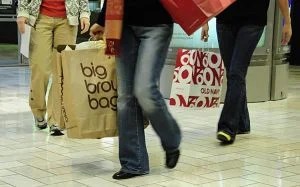The Real Reason for Economic Drag: Huge Drop in Consumer Spending
The American economy is 2/3rd consumer spending. In the 1990, cheap credit boosted consumer spending via revolving. In the 2000s, the meteoric rise in home prices led to consumers tapping their home equity to keep spending (referred to as ‘the Home ATM’). Now, both credit spigots have been stopped. Furthermore, the consumer is already in deep debt.
You might recall this masterpiece Taiwanese animation satire on Black Friday.
In fact, this kind of madness is at the center of ‘economic’ policy of the Feds. We will drop the rate, borrow and go buy something. Saving is for losers. July 15th NY Times has a good article on consumer spending.
NY Times: We are Spent
THERE is no shortage of explanations for the economy’s maddening inability to leave behind the Great Recession and start adding large numbers of jobs: The deficit is too big. The stimulus was flawed. China is overtaking us. Businesses are overregulated. Wall Street is underregulated.
But the real culprit — or at least the main one — has been hiding in plain sight. We are living through a tremendous bust. It isn’t simply a housing bust. It’s a fizzling of the great consumer bubble that was decades in the making.
The auto industry is on pace to sell 28 percent fewer new vehicles this year than it did 10 years ago — and 10 years ago was 2001, when the country was in recession. Sales of ovens and stoves are on pace to be at their lowest level since 1992. Home sales over the past year have fallen back to their lowest point since the crisis began. And big-ticket items are hardly the only problem.
The Federal Reserve Bank of New York recently published a jarring report on what it calls discretionary service spending, a category that excludes housing, food and health care and includes restaurant meals, entertainment, education and even insurance. Going back decades, such spending had never fallen more than 3 percent per capita in a recession. In this slump, it is down almost 7 percent, and still has not really begun to recover.
The past week brought more bad news. Retail sales in June were weaker than expected, and consumer confidence fell, causing economists to downgrade their estimates for economic growth yet again. It’s a familiar routine by now. Forecasters in Washington and on Wall Street keep saying the recovery’s problems are temporary — and then they redefine temporary.




still, if some company like apple comes up with an ipad, people may forego a square meal to get it. The consumerist’s appetite won’t be satiated that easily. 🙂
–ramana